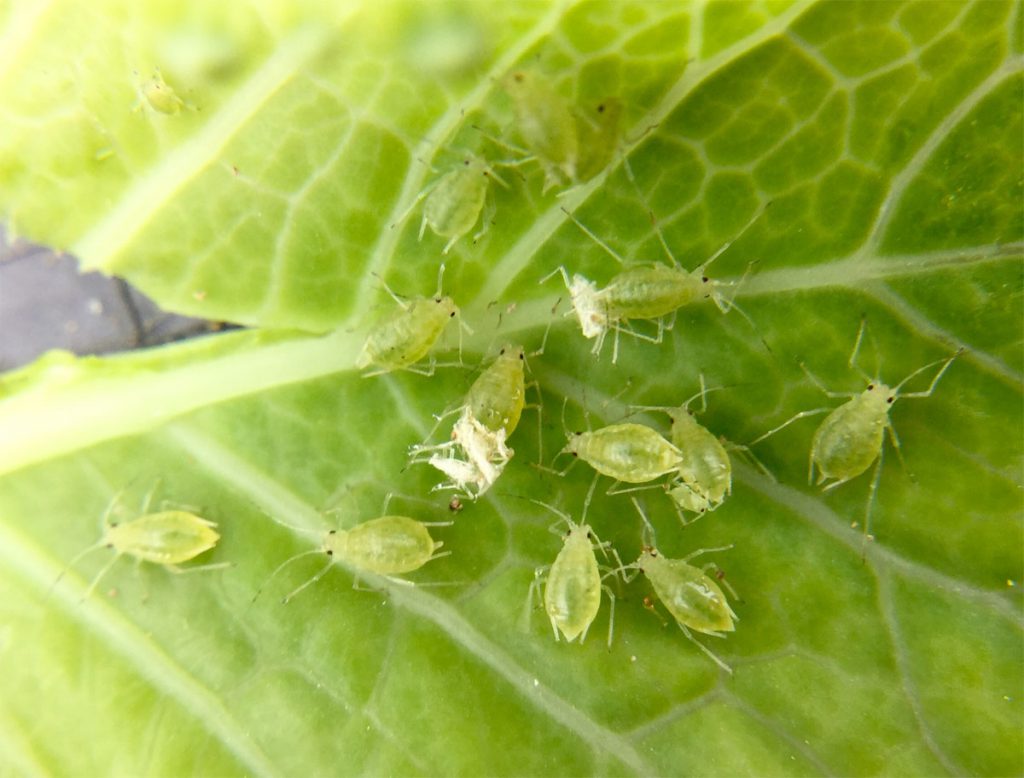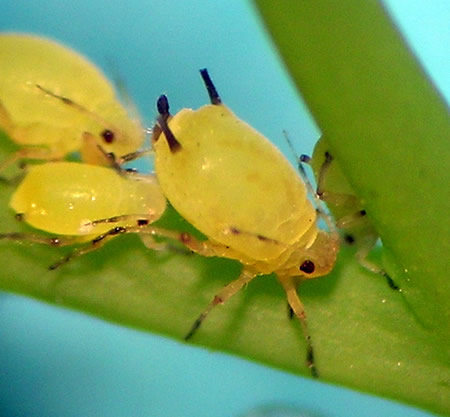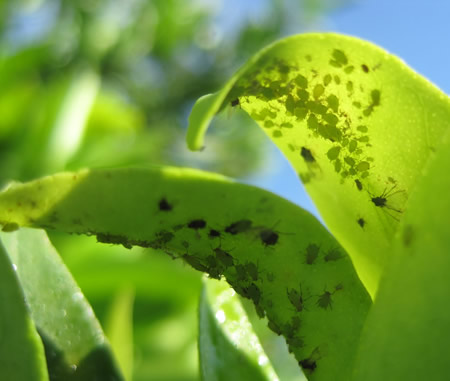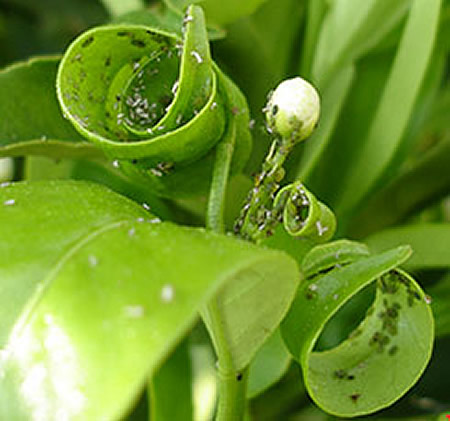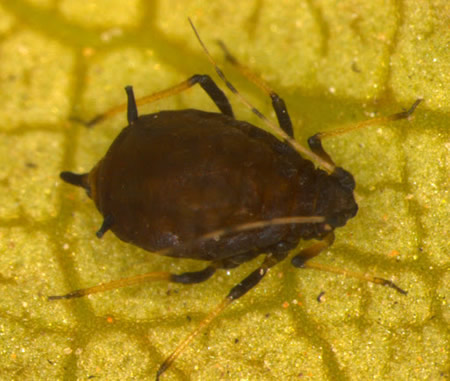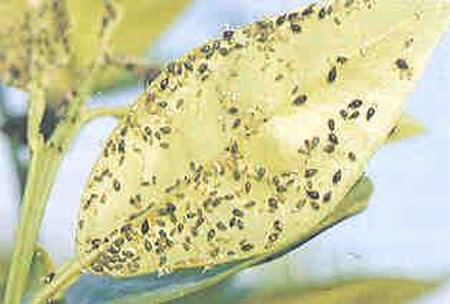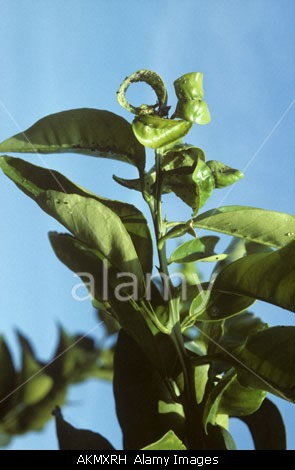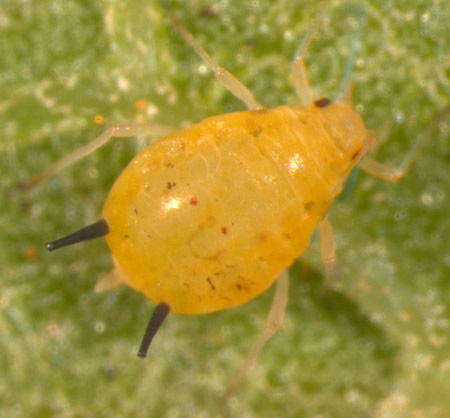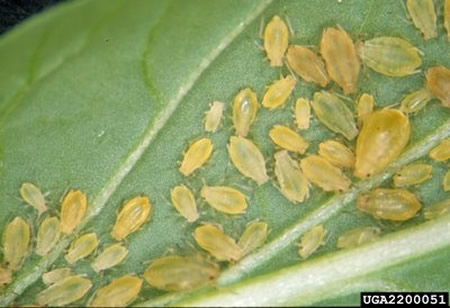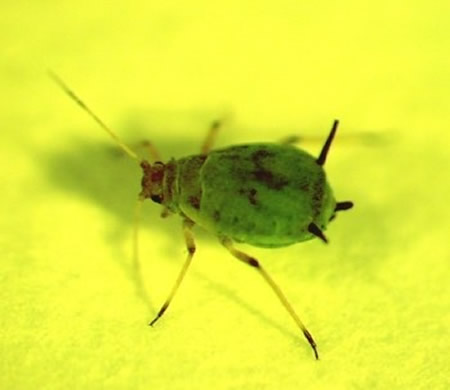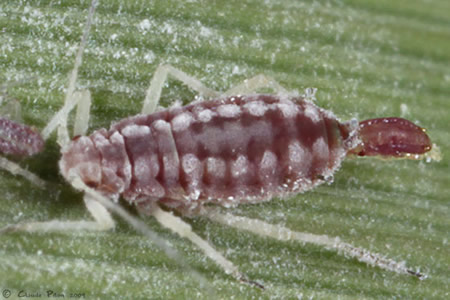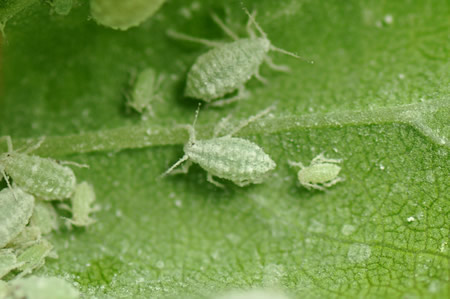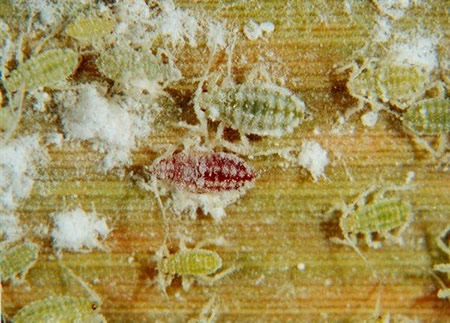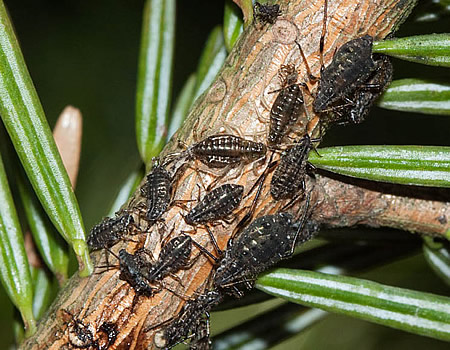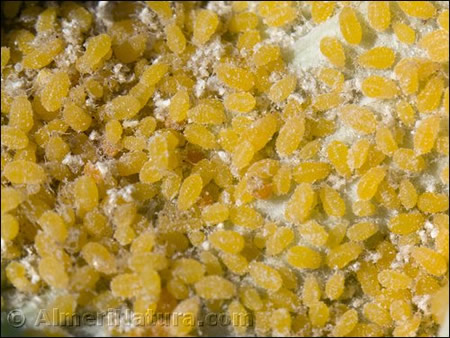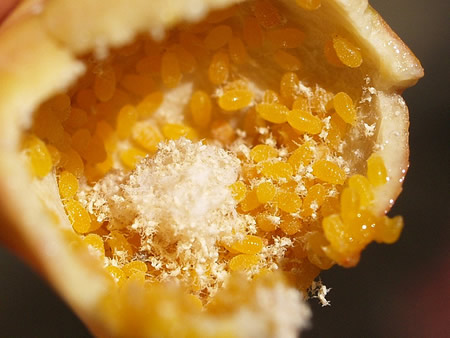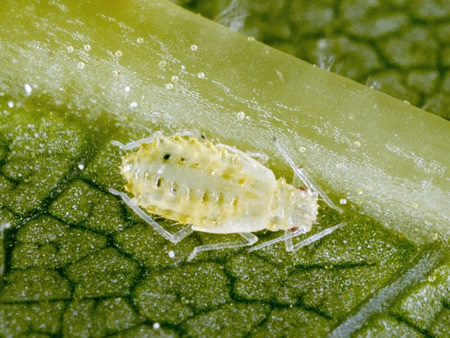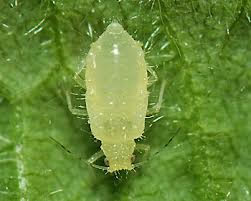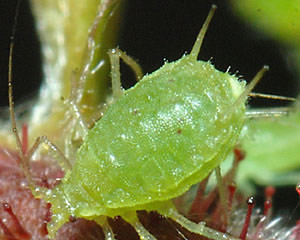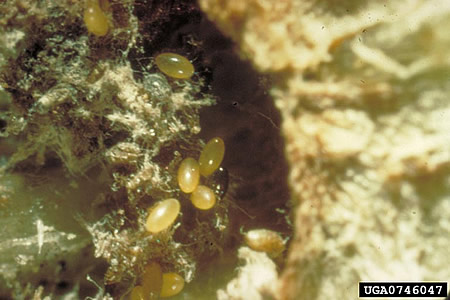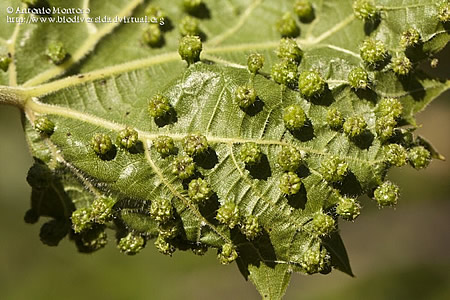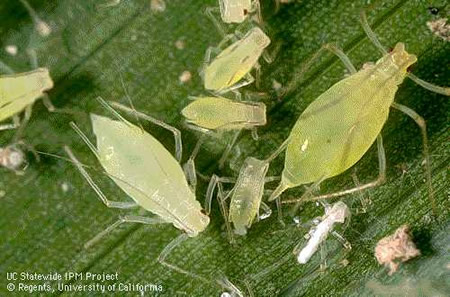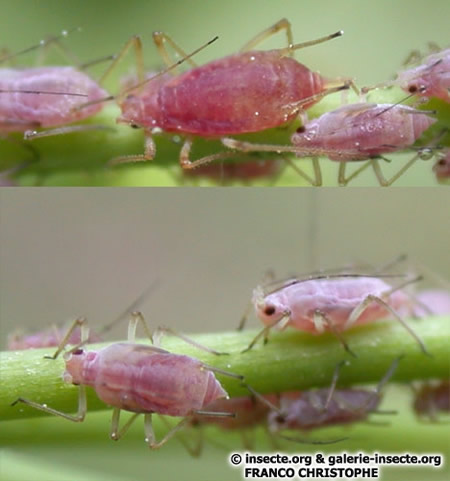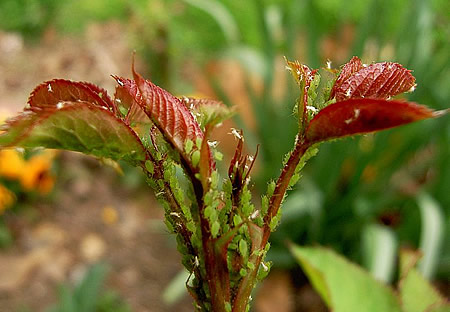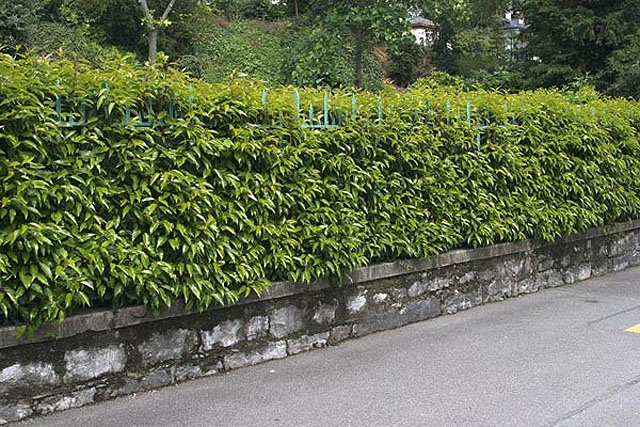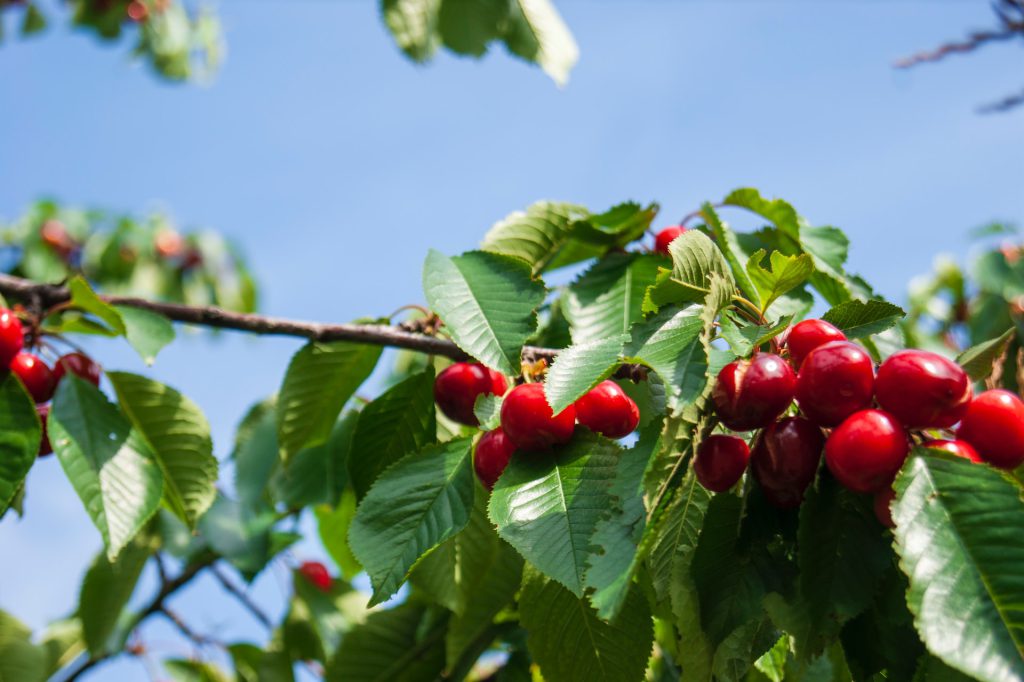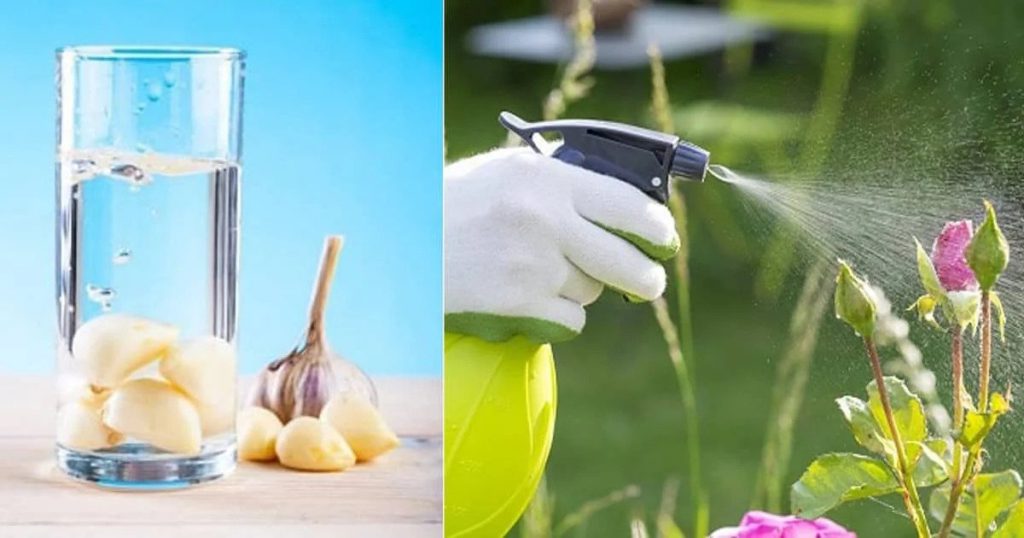Aphids are very well known insects to farmers and gardeners known by the common names aphid, plantlouse, greenfly, ant cow. Most aphids have siphons or horns and a tail. The siphons are conduits that produce alarm hormones so that when the aphid is attacked by an insect or animal, it causes the other aphids to disperse. They are soft-bodied insects, very small, on the order of 1-3 mm.
Aphids live mainly on tender shoots and young leaves of various plants, in groups close to each other with their heads towards the base of the shoot or leaf. Their colonies in spring may cover the entire top part of the shoots.
Aphids are abundant mainly in spring and autumn and generally in moderately warm and humid weather. In spring the females reproduce rapidly, especially if we have new growth.
The hot and dry summer months are not conducive to their continuous breeding but this year conditions are a bit different as we have 35 degrees Celsius on one side and on the other it rains continuously for days.
Their growth is also affected by the presence of reed and wild reed species, in which the aphids find shelter, and even more so if they are adjacent to plants of their preference.
Aphids suck the sap from the plants, cause the leaves to twist (which protects them from spraying and makes it more difficult to control them) and inhibit growth, which also affects the fruitfulness of the plants. They also favor the growth of the tobacco fungus with the sugary honeydew they secrete.
Aphids are the main category of insects that carry viruses, many of them serious, which makes them one of the most harmful pests of crops.
There are many natural enemies and chemical means to combat them. We are going to look at them more specifically in:
- Citrus trees
- Pome fruit: apple, pear and quince trees
- Stone fruit: peach, apricot, plum, cherry, sour cherry trees
- Olive trees
- Tree nuts: almond, pistachio, walnut, hazelnut, chestnut trees
- Vineyard
- Vegetables
- Floriculture plants
Tree crops
Citrus fruits
Citrus trees include the following species: orange, tangerine, grapefruit, neroli, bergamot, lemon, citron, botrytis, Japanese orange, and various hybrids of citrus trees. Among the insect pests, aphids cause damage of great economic importance. The damage varies from year to year and depends on the new vegetation.
In Greece, in our citrus trees, the following three species are most commonly found: Aphis spiraecola, Toxoptera aurantii and Aphis gossypii. Rarely are all three species found to co-exist on our trees.
The temperature that favours the growth of aphids and even their mass growth is between 22 degrees Celsius and 27 degrees Celsius. The aphids settle on the undersurface of leaves and tender shoots, causing curling of the leaves. During the flowering period, which occurs in the first ten days of April, the aphids settle on the flowers, causing considerable damage.
Aphis spiraecola: In Italy and other countries bordering the Mediterranean, it is considered the most damaging aphid of orange and tangerine. A second infestation may occur in autumn.
Figure 1. The green citrus aphid that resembles the aphid that attacks apple trees.
Figure 2. Colony of aphids on the lower leaf surface.
Figure 3. Notice in the photo the curling of the leaves caused by the aphids.
Toxoptera aurantii. It grows especially at temperatures between 22 degrees Celsius and 25 degrees Celsius.
Figure 4. Brown or black citrus aphid.
Figure 5. Colony of the brown aphid.
Figure 6. Leaf curling by aphids on orange tree leaves.
Aphis gossypii: It attacks orange and tangerine most frequently and lemon trees less frequently. It also attacks cotton and is therefore known as ‘the cotton aphid’. It looks very much like the first aphid but its colour is yellow and its legs are transparent.
Figure 7. The aphid Aphis gossypii.
Figure 8. Colony of Aphis gossypii aphids.
Apple trees or pome fruit trees: apple, pear and quince
Aphis pomi: It is otherwise known as the “green aphid” and attacks all three trees. Its color is yellowish green to dark green, with yellow antennas, black siphons, and a black tail. In winter it is found in the form of an egg on shoots and branches, and from spring to autumn, one generation succeeds another. In exceptional cases it also causes deformation of the fruit.
Figure 9. Adult of the green aphid.
Figure 10. Colony of green aphids on an apple leaf.
Dysaphis plantaginea: the pink apple aphid, see article on growing apple trees.
Stone fruits: peach, apricot, plum, cherry, sour cherry tree
Hyalopterus pruni: aphid of stone fruits. The adult is dark brown to black in color, while the juvenile is light green and is a waxy powdery coating that resembles dust. The juvenile’s antennae are shorter than its body and its tail is green.
Figure 11. Adult individual of aphid of stone fruits.
Figure 12. Adult of stone fruits aphid, showing the white coating on their body.
Figure 13. Adult stone fruits aphid together with minors.
Figure 14. Stone fruits aphid adults and juveniles on the lower surface of a plum leaf.
Attacks mainly apricot, plum, peach and less so on the others. It is also found on canes. It occurs on the lower leaf surface without causing curling but can cause fruit drop.
Myzus persicae: green peach aphid, see article on growing peach trees.
Olive tree
Prociphilus oleae: Aphid infesting olive trees, black-bodied, massive and causing damage to leaves, shoots, flowers and fruit. Leaves are deformed and show light-coloured spots.
The adults emerge in June-July and September-October. However, it is not a serious pest of the olive tree since the warm climate of Greece prevents its growth.
Figure 15. Olive aphid.
Control: Spraying with copper containing formulas to limit the expansion of holly-sooty mold.
Tree nuts: almond, pistachio, walnut, hazelnut, chestnut
Aphids found on pistachio trees: Baizongia pistaciae and Geoica utricularia. They are very similar in appearance and belong to the same family.
Figure 16. The aphid Baizongia pistaciae.
Figure 17. The aphid Geoica utricularia inside a pistachio.
Aphids infesting walnut trees: Callipterus junglandis, Chromaphis junglandicola.
Figure 18. The aphid Chromaphis juglandicola.
Aphids affecting hazelnut trees: Myzocallis coryli and Corylobium avellanae.
The first aphid lives on the underside of the leaves of the hazelnut tree and can become abundant. It is found in Europe, southwest Asia, North Africa, Japan, New Zealand, western North America and South America. The second aphid completes its cycle in the hazelnut tree. It feeds on shoots and rarely on leaves. It distributes most of Europe, east to Ukraine and Russia.
Figure 19: Aphid Myzocallis coryli.
Figure 20. The aphid Corylobium avellanae.
Vine
The aphid that infests vines is called the “vine phylloxera” (Viteus vitifoliae). It is a polymorphic aphid which, depending on its form, either exists in the soil and damages the roots or, after the eggs have hatched under the bark, they appear on the upper surface of the tender leaves. Underground, the root system is destroyed, while above ground the growth of the plant is delayed, drying of the leaves and eventually perhaps even drying of the whole plant.
Figure 21. Vine phylloxera aphid eggs.
Figure 22. A form of phylloxera on a vine leaf.
Control: One effective way is to use resistant plants, which means grafting European varieties onto American rootstocks.
Vegetables
Cabbage: Cabbage aphid (Brevicoryne brassicae): the adult is small, greyish-green and covered with powdery mildew. These aphids form clusters on the lower surface of the leaf of cabbage, cauliflower, brussels sprouts and radishes.
Figure 23. Colony of cabbage aphid on the lower surface of the leaf.
Potato: Potato aphid (Macrosiphum euphorbiae): its black eggs hatch on roses and give rise to pink and green young individuals, which feed on the leaves and buds. In early spring they migrate to the potato and are carriers of tomato and potato viruses. It causes curling of leaves and necrosis of flowers.
Figure 24. Greenish young potato aphid individuals.
Figure 25. Young pink potato aphid individuals.
Floriculture plants
Rose bush: The aphid that attacks rose bush is Macrosiphum rosae, where the adult is large, green, with black body appendages and pink spots. Very often found only on rose bushes.
Figure 26. Adult of Macrosiphum rosae aphid.
Figure 27. Adult Macrosiphum rosae aphid individuals on a rose bush.
Chemical control of aphids
1. Mavrik Aquaflow: insecticide with which we spray the foliage. Suitable for the treatment of aphids: on almond trees (0.2 ml/lt of water and 21 days before harvesting the fruit), on apple trees (0.2 ml/lt of water and 90 days before), on pear trees (0.2 ml/lt of water and 90 days before), on peach trees (0.2 ml/lt of water and 56 days before), on citrus trees (0.2 ml/lt of water and 28 days before) and on ornamentals (0.2 ml-0.4 ml/lt of water).
2. Pearl 100 EC: toxic to bees and aquatic organisms. Suitable for: apple, pear, quince (0.075ml-0.125 ml/lt water and 7 days before harvest), peach, apricot, plum, cherry and sour cherry (similar to above), almond, hazel, walnut (0,075 ml/lt of water and 30 days before harvest), cabbage (0,075 ml/lt of water and 7 days earlier), cucumber (0,125 ml/lt of water and 7 days earlier). Finally, for ornamentals it is 0,125 ml/lt of water.
3. Poleci 2.5 EC: Suitable for: vine (0.5 ml/lt of water and 7 days before harvest), tomato and cucumber (0.5 ml/lt of water and 3 days ahead), cabbage (0.3-0.5 ml/lt of water and 7 days ahead), plum, cherry, apricot and peach (0,3-0,5 ml/lt of water and 7 days earlier), pear and apple (0,3-0,5 ml/lt of water and 7 days earlier). For ornamentals (0,08-0,1 ml/lt of water/10 m2 and 3 days before harvest) and for ornamental plants (0,1-0,2 ml/lt of water).
4. Spruzit EC: Suitable for rose, carnation, chrysanthemum and other ornamentals but not for poinsettia. More suitable for amateur use. Apply preferably in the early morning or afternoon and not under high temperatures and direct sun exposure. Plants may develop an oily and greasy appearance after use of the product. After spraying, direct exposure to strong sunlight may cause damage to plants. A suitable quantity is 10 ml/lt of water.
All the above formulations are indicative. There are too many on the market.
Biological control of aphids
1. Water: Soak the plant and then drench it with cotton or a cloth. If the plant is tough and doesn’t break easily don’t hesitate to use water under pressure to eliminate any honeydew in one go!
2. Soapy water. Perhaps some of you may know it along with alcohol but I don’t recommend it because in recent years, strange as it may seem, aphids have shown a “resistance” to alcohol and instead of decreasing, there are cases where they increase.
3. Natural Pyrethrum: Produced from the chrysanthemum Chrysanthemum cinerariaefolium and related species C. roseum and C. carneum. Acts: mainly as a contact insecticide, but is not selective for beneficial insects, so should only be used in cases of severe problems. Natural pyrethrum is a broad-spectrum insecticide and therefore can be used for honeydews, caterpillars, various flies. Spray 48 hours before consumption.
4. Azadirachtin: produced from the Azadirachta indica or Neem tree and is active against many insects such as honeydews, caterpillars, beetles etc. Last spray before consumption is three days.
5. Herbs: Near the rose bush, plant garlic.
Near the cabbage, plant watercress (nasturtium) and mint.
Near the corn, plant sunflower (but without having strong effect to aphids).
Near the potato, plant coriander.
Near the tomato, plant petunia and watercress.
Near the cucumber plant watercress.
All of the above act as insect repellents for aphids.
6. Stinging nettle juice: Leave nettles in water for 10 days and then spray with a 1:5 ratio diluted with water.
7. Ladybugs: Ladybugs (ladybird beetles) are natural enemies of aphids. Ladybugs can control aphids through natural predation.
Agronomist Sophia Papazoglou
Agronomist, Msc “Environmental Management”
Tags: APHIDS • PLANT PROTECTION • SOFIA PAPAZOGLOU AGRONOMIST

